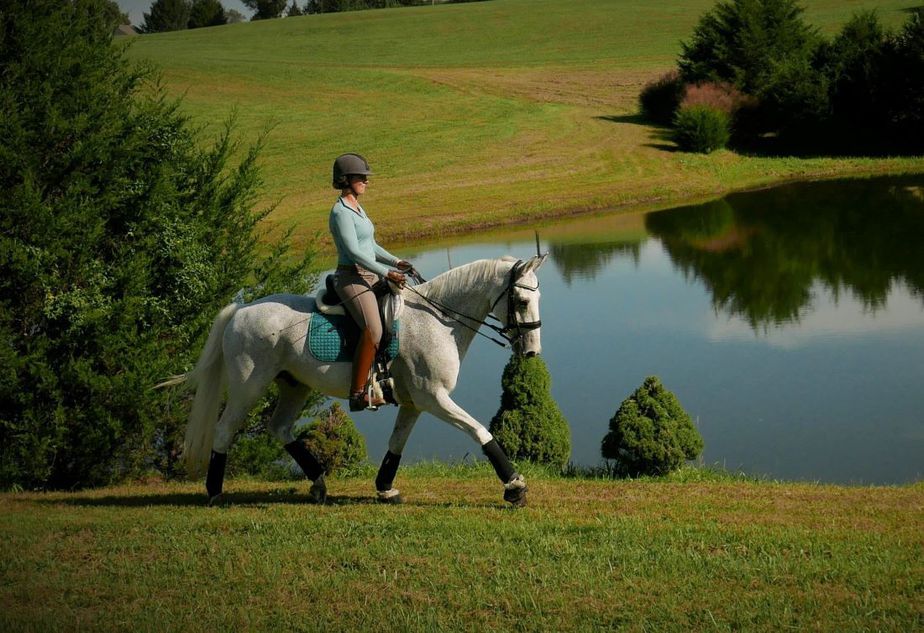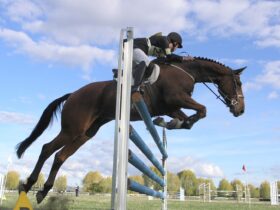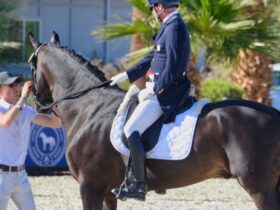—Lisa Hellmer
Dressage is a sport of constant repetition in the movements, but also in the environment we ride in. Dressage riders often confine themselves to the 20×60 meter arena, or as I often refer to it: “The Sandbox.”
A surprising amount of dressage horses are mentally and physically unable to leave the sandbox. Some horses have never trained on uneven or imperfect footing, only on level ground in a perfect rectangle. Some horses don’t ever traverse through nature and remain terrified of the leaf blown skittering across the ground, the crunchy gravel path, or the dreaded bottomless puddle. Not only is this problematic for the horse, but it becomes our problem to fend off all of these monsters whenever we take our horse away from home—like on those show days when we hope to present a relaxed and focused horse in our test…
There are ways to increase our horse’s bravery and balance by taking our training outside of the ring. One of the great things about riding outside is facing the unexpected. Seeing a bird flying overhead, a gust of wind blowing the grass, or squirrels rustling in the trees. It doesn’t seem like much at first, but riders often totally overlook the need to desensitize their horse to these everyday elements.
If we are always stuck riding in an indoor or enclosed arena, we don’t run into and stand our ground against these perceived monsters; this means your horse might have their first real outside experience at a show, which is less than ideal. By riding outside and exposing our horses to the sights and sounds of the great outdoors, riders learn to anticipate and react to situations when/where their horse may spook, how to overcome and move on from distractions, and to build trust and confidence in their partnership.

The other wonderful benefit of riding outside of the sandbox is the various terrain. Whether you ride on grass, sand, dirt trails, or even sometimes gravel, your horse must learn to balance and develop body awareness. Riding up or down hills on various grades is very different from riding in the arena.
Maintaining balance, rhythm, and straightness outdoors is just as important as in the ring. Riding up and down hills builds strength in the horse’s hind end, over the back and topline. Various terrain also improves your horse’s dexterity, balance, and confidence. And, as mentioned in my other posts, these various grades can also serve as training aids to make schooling certain movements easier or more challenging, depending on your goals.
This variety can also improve mental clarity for both horse and rider. A change of scenery can make a world of difference to your horse. A challenging movement may seem much easier now in a different environment. Sometimes we just need to change the situation in which we ask our horse a question to get the answer we are looking for. Remember to look around, take a deep deep breath, and enjoy the great outdoors with your horse! Have Fun!
LCH Equestrian
www.lisahellmer.com
 @LCHEquestrian
@LCHEquestrian
 @LHdressage
@LHdressage
Lisa Hellmer is working toward the Grand Prix with her Oldenburg “Aniko.” She graduated summa cum laude from Johnson & Wales University with a degree in equine business management and riding. As a former event rider, Lisa brings that experience into building EQuine AMerica’s Cavaletti Crossfit posters and her cross-training lessons, which you can find here. Recently, Lisa became a USEF Silver Para Dressage Coach and formed LCH Equestrian in Ocala, FL where she continues to focus on dressage, para dressage, and cross-training the dressage horse.






















SOCIAL